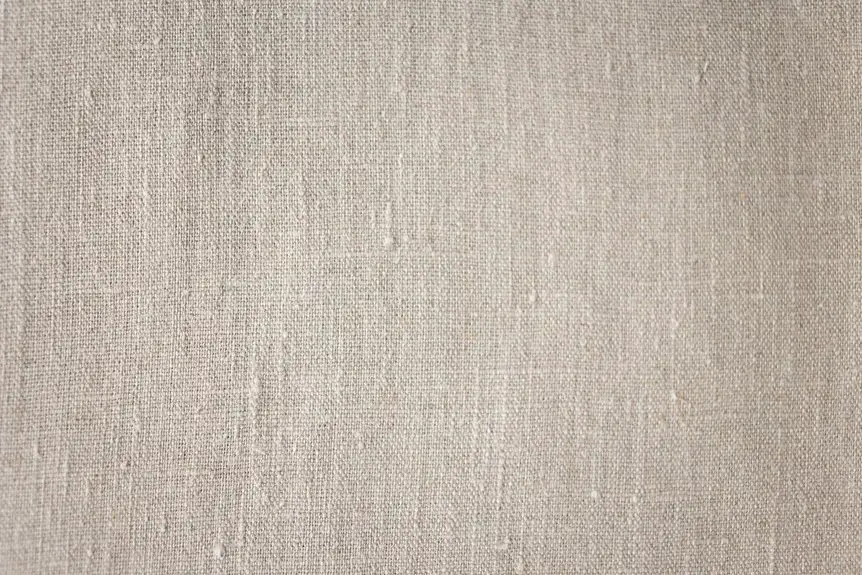If you want durability and crisp texture, go with linen—it’s strong, breathable, and great for hot climates but wrinkles easily. Cotton gauze feels softer, lighter, and more delicate, offering gentle warmth and airy comfort, perfect for casual wear or mild weather. Both need gentle care but suit different needs depending on style and climate. Keep exploring to discover how each fabric fits your lifestyle and home decor perfectly.
Table of Contents
Key Takeaways
- Linen is stronger and more durable, ideal for structured clothing and long-lasting home decor items.
- Cotton gauze is softer, lightweight, and airy, perfect for casual wear and delicate home textiles.
- Linen excels in hot climates due to its moisture-wicking and breathable properties.
- Cotton gauze offers gentle warmth, suitable for milder or cooler conditions.
- Linen requires more care to avoid wrinkles, while cotton gauze needs gentle washing to prevent stretching.
Understanding the Origins and Production of Linen and Cotton Gauze
Though both linen and cotton gauze share a lightweight, breathable texture, their origins and production methods set them apart.
Linen comes from flax plants, where fibers are extracted through retting and then spun into threads. This process requires patience and skill, making linen a durable and eco-friendly fabric.
Cotton gauze, on the other hand, originates from cotton plants. The fibers are harvested, cleaned, and woven loosely to create that soft, airy gauze texture. You’ll find that cotton gauze production is generally less labor-intensive than linen’s.
Understanding these differences helps you appreciate the unique qualities each fabric offers, influencing your choice based on sustainability, texture preferences, or fabric strength.
Knowing where and how they’re made lets you select the right fabric for your needs.
Comparing the Texture and Appearance of Linen and Cotton Gauze
When you touch linen and cotton gauze, you immediately notice their distinct textures. Linen feels crisp and slightly rough, with a natural stiffness that softens over time. Cotton gauze, on the other hand, is lightweight and airy, offering a soft, crinkled texture that feels gentle against your skin. Visually, linen presents a smooth, matte finish with subtle irregularities, while cotton gauze looks more textured and semi-transparent with a loose weave.
| Feature | Linen | Cotton Gauze |
|---|---|---|
| Texture | Crisp, slightly rough | Soft, crinkled, airy |
| Appearance | Smooth, matte, irregularities | Textured, semi-transparent |
| Feel on Skin | Firm, softens with use | Gentle, breathable |
Assessing Durability and Care Requirements for Each Fabric
Understanding how linen and cotton gauze feel and look is just one part of choosing the right fabric. You’ll want to take into account durability and care to guarantee your fabric lasts.
Linen is known for its strength and tends to become softer with each wash without losing integrity. It resists wear and tear well but wrinkles easily, so you might need to iron it if you prefer a crisp look.
Linen combines durability with softness, becoming gentler each wash while maintaining its sturdy nature.
Cotton gauze, on the other hand, is lightweight and delicate. It can be prone to stretching or fraying if not handled gently. You should wash it on a gentle cycle and avoid harsh detergents.
Both fabrics benefit from air drying, but cotton gauze requires more careful handling to maintain its texture and shape over time.
Evaluating Breathability and Comfort in Different Climates
Because you want to stay comfortable no matter the weather, choosing between linen and cotton gauze depends largely on how well each fabric breathes.
Linen excels in hot, humid climates thanks to its natural moisture-wicking and quick-drying properties, keeping you cool and dry. It allows air to circulate freely, making it ideal for summer wear.
Cotton gauze also offers good breathability but feels softer and lighter against your skin, making it a great option if you prefer a delicate touch. In milder or cooler climates, cotton gauze’s gentle warmth and layered texture can provide comfort without overheating.
Ultimately, consider your local climate and how active you’ll be to pick the fabric that keeps you feeling fresh and comfortable all day.
Best Uses for Linen and Cotton Gauze in Fashion and Home Decor
Although both linen and cotton gauze offer unique textures and benefits, choosing the right fabric for your fashion and home decor projects depends on your style and function needs.
Linen works wonderfully for structured clothing like blazers, trousers, and summer dresses, thanks to its durability and crisp feel. In your home, linen shines in curtains, tablecloths, and bedding, adding a natural, elegant touch.
Cotton gauze, on the other hand, suits casual, lightweight garments such as baby clothes, scarves, and loose tops because of its softness and breathability. For home decor, it’s perfect for throws, cushion covers, and sheer curtains that create a cozy, relaxed atmosphere.
Frequently Asked Questions
Are Linen and Cotton Gauze Fabrics Hypoallergenic?
You’ll find both linen and cotton gauze are generally hypoallergenic, making them great if you have sensitive skin. They naturally resist irritants and allergens, so you won’t have to worry about common fabric allergies when wearing them.
How Do Linen and Cotton Gauze Fabrics Impact the Environment?
When you choose fabrics, you hold the planet’s fate in your hands. Linen uses less water and pesticides, making it eco-friendly, while cotton gauze often demands more resources, so you’ll want to check its sourcing carefully.
Can Linen or Cotton Gauze Be Used for Baby Clothing?
You can definitely use both linen and cotton gauze for baby clothing. They’re soft, breathable, and gentle on sensitive skin. Just choose pre-washed, organic options to avoid irritation and guarantee your baby stays comfy all day.
Which Fabric Is Better for People With Sensitive Skin?
If you have sensitive skin, you’ll likely prefer cotton gauze because it’s softer and less abrasive. It’s breathable and gentle, reducing irritation. Linen can feel rougher, so cotton gauze usually suits sensitive skin better.
Are There Any Common Allergens Found in Linen or Cotton Gauze?
You’d think fabrics would be allergen-free, right? But both linen and cotton gauze can carry dust mites or chemical residues from processing. If you’re sensitive, you’ll want to wash them thoroughly before use to avoid reactions.
- Tetron Fabric for Marine Applications: Durability and Use Cases - June 18, 2025
- Tetron Fabric for Outdoor Furniture: Weather Resistance and Care - June 18, 2025
- Tetron Fabric for Wall Coverings: Style and Application Tips - June 18, 2025







